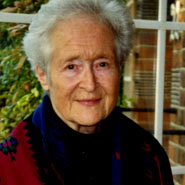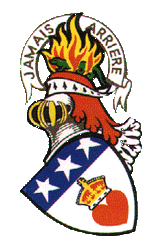|
 Dame Mary Douglas was one of the outstanding British social
anthropologists of the latter half of the 20th century. Her books, Purity
and Danger (1966) and Natural Symbols (1970), were seminal for
anthropologists and were widely appreciated in other disciplines. Dame Mary Douglas was one of the outstanding British social
anthropologists of the latter half of the 20th century. Her books, Purity
and Danger (1966) and Natural Symbols (1970), were seminal for
anthropologists and were widely appreciated in other disciplines.
She was born as Margaret Mary Tew in Sanremo, Italy, to Gilbert and Phyllis (née
Twomey) Tew. Her father was in the British colonial service. Her mother was a
devout Roman Catholic, and Mary and her younger sister, Patricia, were raised in
that faith. After their mother's death, the sisters were raised by their
maternal grandparents and attended the Roman Catholic Sacred Heart Convent in
Roehampton. Mary went on to study at St. Anne's College, Oxford, from 1939 to
1943; there she was influenced by E. E. Evans-Pritchard. She graduated with a
second-class degree.
In the early 1950s, she completed her doctorate and married James Douglas. Like
her, he was a Catholic and had been born into a colonial family (in Simla, while
his father served in the Indian army). They would have three children. She
taught at University College, London, where she remained for around 25 years,
becoming Professor of Social Anthropology.
A Sunday Times survey of “Makers of the 20th Century” in 1991
listed Purity and Danger among the 100 most influential nonfiction
works since 1945; only four women and four anthropologists made the list.
Starting as an Africanist, she branched out to cover contemporary Western
society, addressing such topics as risk analysis and environmentalism, and
food and consumption. Old Testament religion was another interest, first in
her famous discussion of the “abominations of Leviticus”, in Purity and
Danger, and latterly in studies of Numbers and Leviticus.
Douglas aroused strong opinions among fellow anthropologists, partly
because of her personality but also because of her dismissal of people whose
work she did not rate. “The time has come to topple Mary Douglas from her
pedestal” was the headline to an article in The Times Literary Supplement.
Her intellectual self-confidence was combined with a sense of driving
purpose. Some found her divisive as she used her penetrating intellect to
force home a conclusion. She seemed to sense herself as an outsider,
although she stood in the central tradition of Durkheim-descended British
social anthropology. She held few institutional positions in her discipline,
but many of her ideas and insights entered its general patrimony. As a
follower of Durkheim she had to contend with the different perspectives of
those who looked to Max Weber or Karl Marx.
Her interest in food as “a system of communication” provoked protests in
the House of Commons. Because some of this research had public funding via
the Social Science Research Council, MPs raised hostile questions about its
usefulness, and scathing references were made to “the sociology of the
biscuit”. She justified herself vigorously, claiming that study of the
social costs of changes in eating habits on grounds of advice, availability
of food, and changes in price or incomes was useful.
Mary Douglas was very much the product of her up-bringing. She was born
in San Remo in 1921, where her parents had stopped while returning home from
Burma. Gilbert Tew, her father, was a member of the Indian Civil Service. Of
working-class background, he won a scholarship to read classics at Emmanuel
College, Cambridge. He wrote much on angling and in her last years Douglas
edited his writings for publication. She inherited her good looks and her
religion from her mother, Phyllis Twomey, an Irish Catholic.
When her mother died, Mary was 12 and her younger sister 9, and their
grandparents in Devon brought them up. The two girls were awarded bursaries
to board at Sacred Heart School in Roehampton. The nuns, if not quite proxy
parents, shaped Mary’s values – values which would be reflected in much of
her work on institutions, rules, symbols and hierarchy. The nuns may also
have fired her ambition to excel; in her later professional career she
sought scholarly approbation and seemed almost to court disciples.
After graduating in PPE at Oxford in 1943, she served in the Colonial
Office until 1947. This proved to be significant because Britain still ruled
a vast empire and she met a number of anthropologists. She then enrolled as
a research studen at the Oxford Institute of Social Anthropology, headed by
E. E. Evans-Pritchard, an Africanist and then the leading practitioner of
the discipline. Few universities offered anthropology and the institute was
the place for training as Africa was the place for fieldwork.
Supported with a war veteran’s grant, Douglas began fieldwork for her
DPhil in 1949, studying the Lele, a matrilineal society living on the
forest/ savannah divide in the remote highlands of the southern Belgian
Congo.
In 1951 she accepted an anthropology lectureship at University College
London and married in the same year. For the next few years she concentrated
on caring for her family and completing her doctorate (in 1953). She
published her monograph, The Lele of Kasai, in 1963. British
reviewers were less than appreciative of research in French-speaking Africa,
and French anthropologists in turn did not engage with work written in
English. The book was, many years later, translated into French.
Douglas returned to the Lele in 1987 and was depressed at the region’s
ecological degradation and the complicity of the indigenised Catholic Church
in vicious witch-killing.
Purity and Danger – An Analysis of the Concepts of Pollution and Taboo
testified to an outstanding talent. Drawing widely on different sources and
disciplines and her Lele research, Douglas explored the relationships
between dirt, holiness, impurity and hygiene. The book had a great impact
outside anthropology, went through numerous editions and was translated into
at least 15 languages.
Natural Symbols (1970) received a more mixed reception among
anthropologists. It was felt to have taken the insights of Purity and
Danger too far, and some disliked its defence of Catholic
traditionalism.
It introduced the “group” and “grid” tools of analysis, so characteristic
of her later work.
The first referred to the clarity of the boundaries around a group to
which people belong; the second to the strength of the rules which govern
how people relate to one another. Thus, a hierarchical society with strong
ties scores highly on group and grid, but an individualist or market-driven
one will be weak on both.
In these years Douglas also emerged as something of a public figure,
writing frequently in New Society (a social science weekly founded in
1962) and giving talks on the BBC Third Programme, many of which were
published in The Listener.
She was promoted to a personal chair at UCL in 1970, one of a very few
women professors in the social sciences in Britain. Family and research were
her priorities; she avoided university committees and was never head of
department. Although not a feminist, she brought to her work the feminine
concerns of the home, its meals and upkeep, the domestic rituals of
cleaning, shopping and marking special events with friends and family
Douglas spoke rapidly in lectures and seminars, and students quickly became
aware of her energy, engagement with the subject to hand and her remarkable
intellect. But she was also formidable; forthrightly and doggedly
challenging what she regarded as slipshod thinking or careless expression.
Having “done” Africa, her interests extended to contemporary Western
society; she published on such subjects as risk analysis and the
environment, consumption and welfare economics, and food and ritual, all
increasingly cited outside anthropology circles. The World of Goods
(1978), for example, was written with an econometrician, Baron Isherwood,
and was a pioneering work on economic anthropology.
Douglas could spot the symbolic significance of the most humdrum
activities such as the choice of food and seating arrangements at meals. She
argued that the changes in Vatican II, affecting the Mass, abstinence and
the habits worn by some religious orders weakened the social rituals and
thereby the social boundaries of Catholicism. Indeed, some complained that
on occasion her work displayed her religion too openly; one critic dismissed
Natural Symbols as Roman Catholic propaganda.
It would be difficult to understand Douglas without appreciating her
devotion to her husband James. Both had parents from the Anglo-Indian world
and inherited their Catholicism from their mothers. James Douglas was
director of the Conservative Research Department between 1970 and 1974.
Widely respected for his intellect and ability to transcend disciplinary
boundaries, he stimulated and encouraged her to look beyond anthropology in
her work. She turned down offers of chairs elsewhere because of her concern
for his career. Both were Conservatives of the R. A. Butler kind, even
Christian Democrats. They were out of sympathy with Thatcherism and
Reaganism, regarding the emphasis on competition and individualism as a
licence for selfishness and a cause of social divisions. By 1977, with their
children grown up and James having retired, Mary Douglas, finding British
university life less congenial (the anthropology department at UCL was
becoming increasingly factionalised), opted to spend the next 11 years in
the US. After four years (1977-81) as Foundation Research Professor of
Cultural Studies at the Russell Sage Institute in New York, she moved to
Northwestern University as Avalon Professor of the Humanities with a remit
to link the studies of theology and anthropology. She was elected FBA in
1989 and appointed CBE in 1992.
In the 1970s she had begun a productive collaboration at Sage with Aaron
Wildavsky, the brilliant political scientist at the University of California
Berkeley. They co-wrote Risk and Culture(1982); subtitled “An essay
on the selection of technologies and environmental dangers”, it studied the
perceptions of risk prompted by the concerns of the US ecological movement.
Ten years later she collected a volume of essays on the theme of Risk and
Blame. In 1987 she published the influential How Institutions Think.
In later years she studied the impact of modernisation on religion,
noting the revival of traditional and even fundamentalist religions, for
example Christianity in the US and Islam in the Middle East. She also
immersed herself in the Old Testament, learning Hebrew and drawing on the
help of Hebrew scholars to produce In the Wilderness (1993), a study
of the book of Numbers, and Leviticus; A Literature (1999).
In her eighties she did not slow down in spite of a serious illness and a
mugging in Waterlow Park, North London, on her return from church. She
continued to write and travel, receiving awards and giving distinguished
lectures. She enjoyed domestic chores and she and James (both fine cooks)
were generous hosts at their house on the Holly Lodge estate in Highgate,
London. They had simple tastes, were not particularly interested in the
arts, and most of all enjoyed vigorous discussion, leavened with a little
gossip about politics and academe. Until James’s death in 2004 theirs was a
marriage of minds as well as hearts.
Douglas was appointed DBE in the last New Year’s Honours List. She is
survived by two sons, James and Philip, and daughter, Janet. Her husband,
Professor James Douglas, died in
2004.
Professor Dame Mary Douglas, anthropologist, was born on March 25,
1921. She died on May 16, 2007, aged 86. From The Times, May 18, 2007
|


